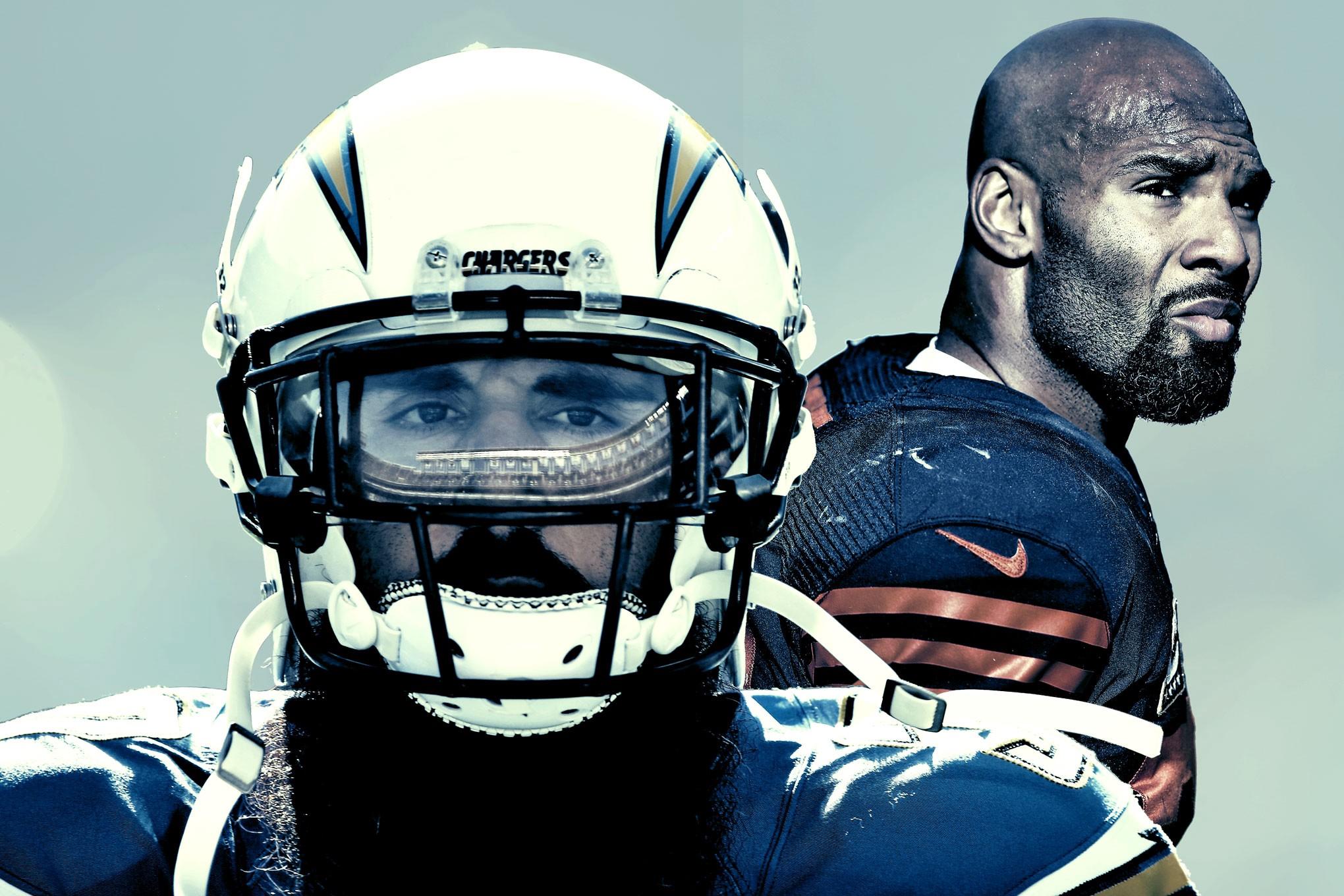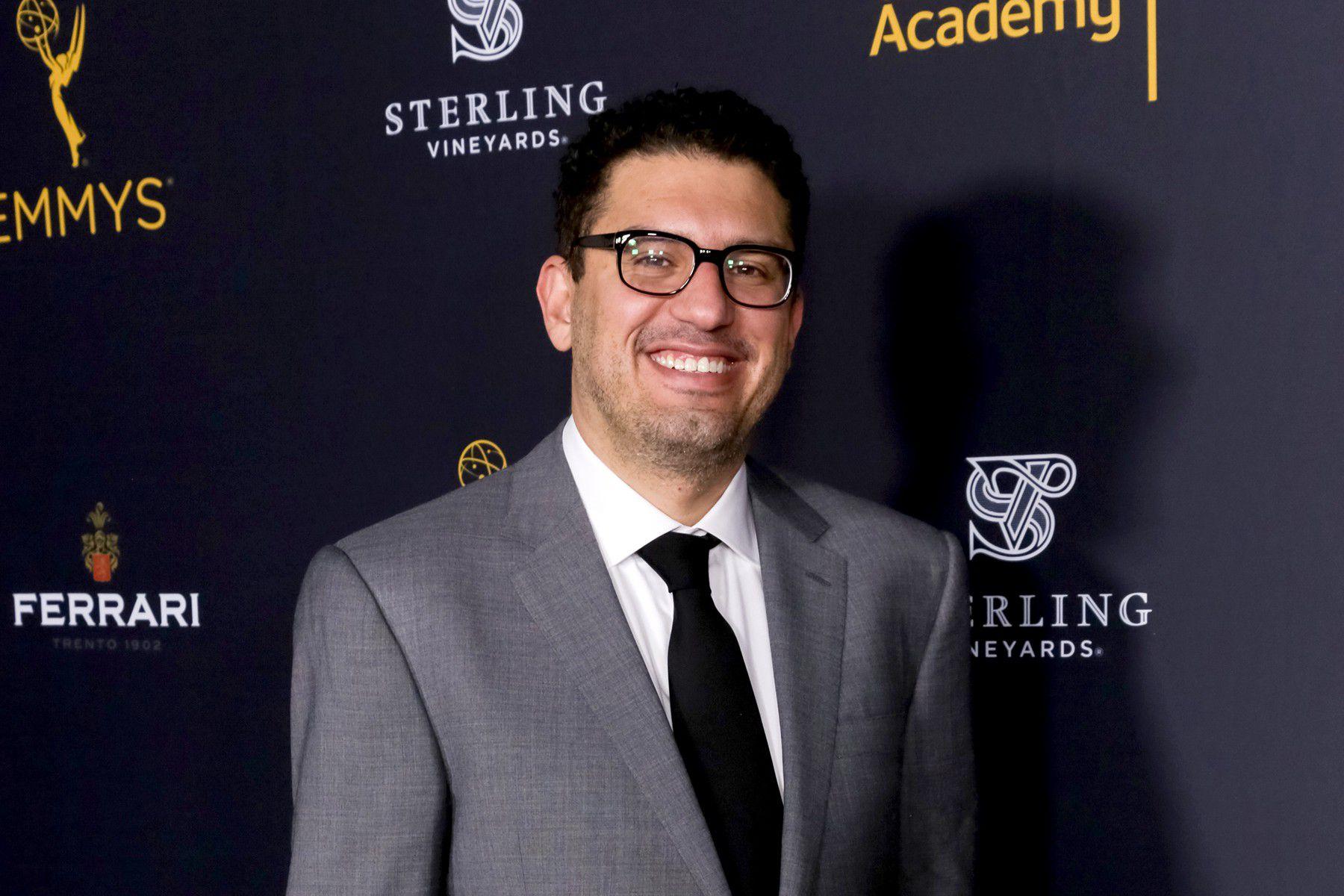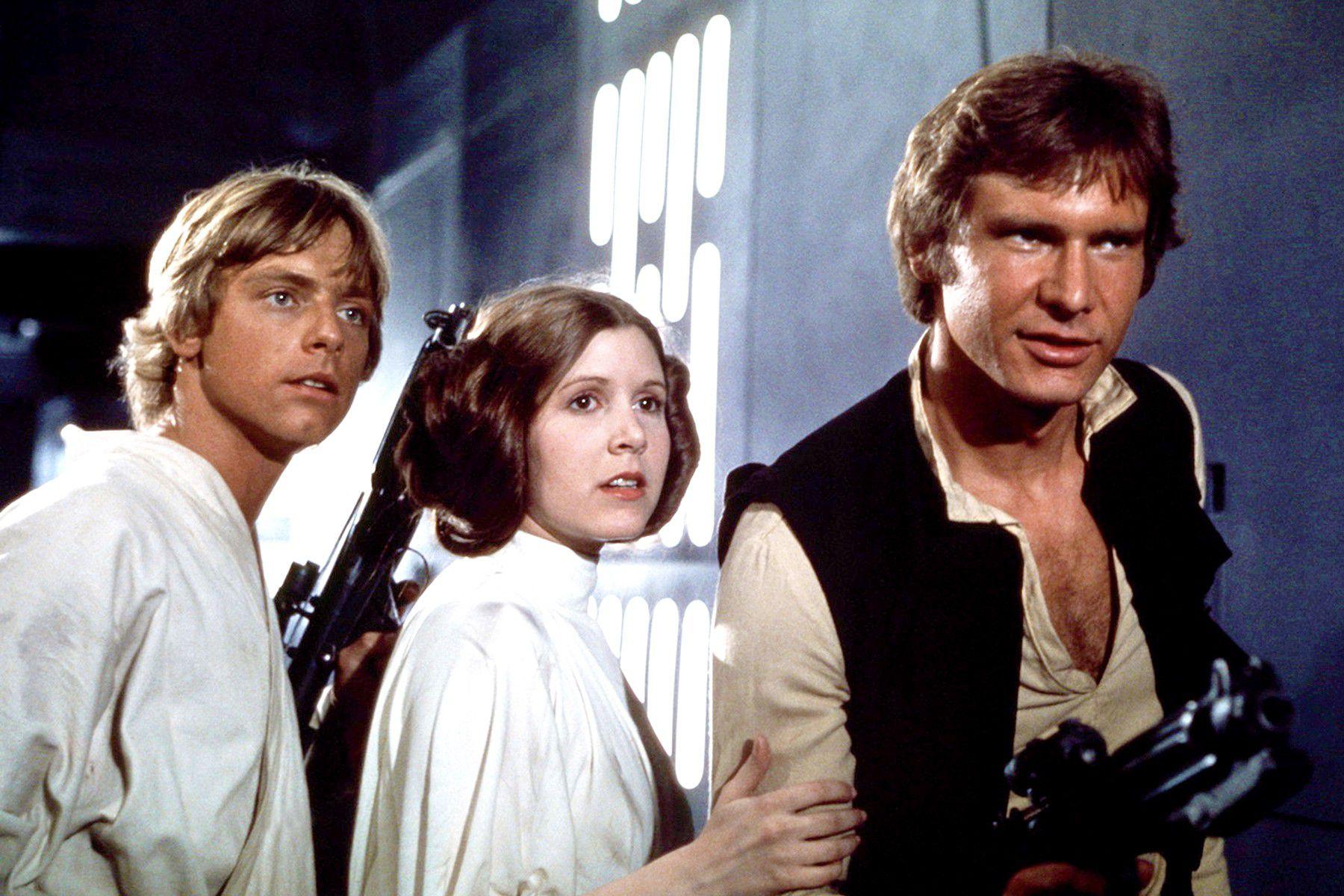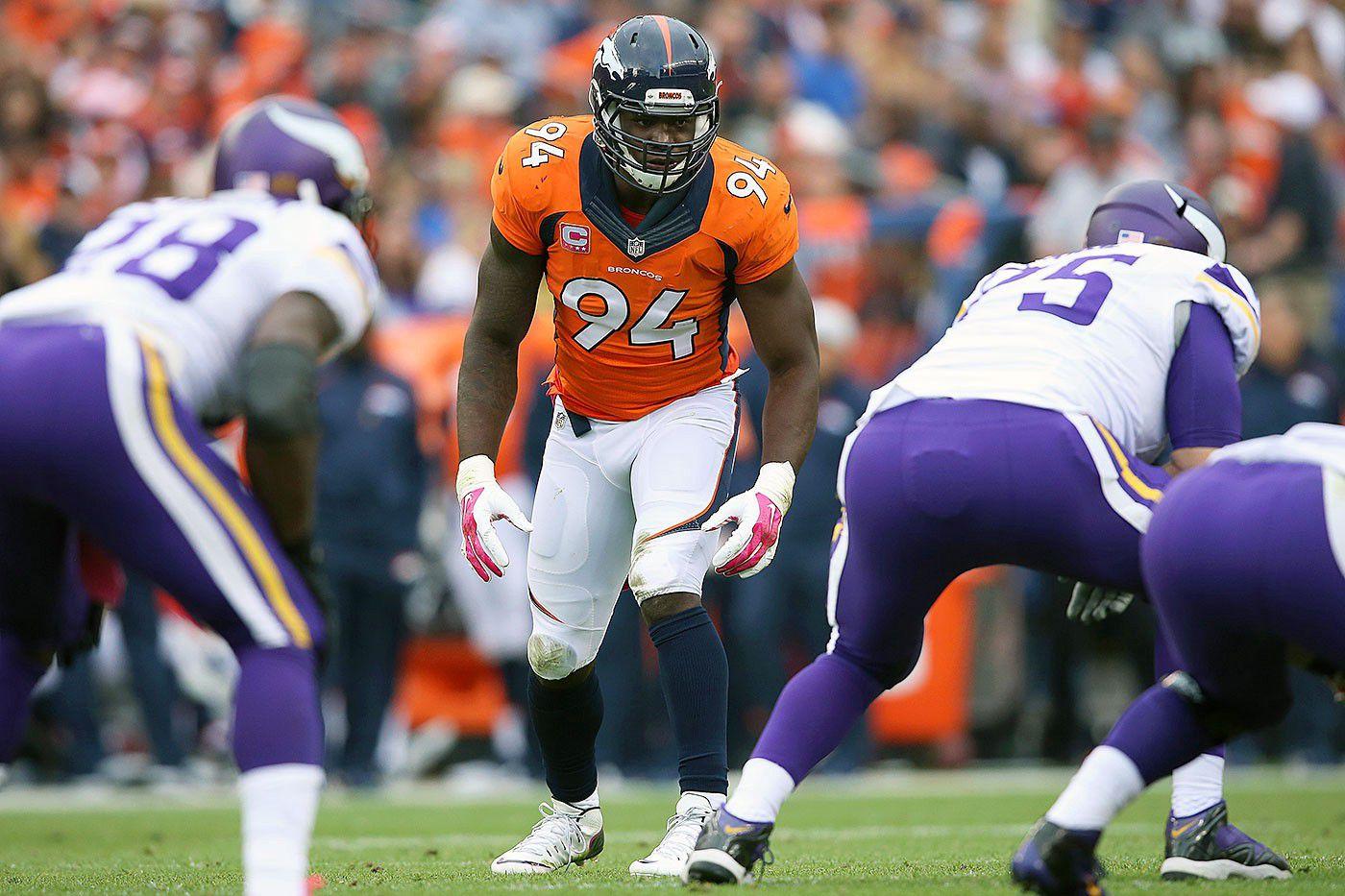
Rare is the NFL career that ends the way most fans would hope: with a player walking off the field for the last time wearing the same uniform that made him famous. John Elway managed to do it. Barry Sanders did, too. But so many other football greats — including Jerry Rice, Joe Montana, and Emmitt Smith — finished their careers in places that would have seemed foreign only years earlier.
Not all late-career team changes are created equal, though. They come in different forms, are prompted by many kinds of motivation, and find varying levels of success. And to truly understand the outlook for a few big-name veterans who changed cities for the first time this offseason, such as Eric Weddle and Matt Forte, it’s worth revisiting some similar types of moves from the past.
Category 1: Being Dealt Away for Assets
Some of the higher-profile moves in recent memory have involved pragmatic franchises milking all they could out of an aging star’s perceived value. The Packers’ Brett Favre trade — which happened eight years ago — might be the most noteworthy example. In August 2008, with Aaron Rodgers waiting in the wings, Favre reportedly told coach Mike McCarthy that he wasn’t interested in playing for the team that season. Rather than release the quarterback, Green Bay dealt Favre to the Jets for a conditional draft choice that eventually became a third-round pick in the 2009 draft.

Favre’s case is more complicated than others in this category, as trading him offered the Packers a chance to not only see a return for an aging veteran, but also to usher in a new era. That’s not normally a consideration at non-quarterback positions, so most moves of this type occur for a far simpler reason: It gives teams a way to recoup value from a guy who still has something substantial left to offer.
For instance: the Tony Gonzalez trade in 2009. Gonzalez was a guaranteed Hall of Famer when the Falcons called Chiefs general manager Scott Pioli and offered him a second-round pick in exchange for the most accomplished pass-catching tight end ever. Kansas City had gone 2–14 in 2008, and the decision to deal Gonzalez — who had somehow managed 96 catches, 1,058 yards, and 10 touchdowns that season while playing with the Tyler Thigpen–Brodie Croyle–Damon Huard Axis of Quarterback Misery — meant giving an all-time great one final chance to contend. “From an organizational as well as personal standpoint there are mixed emotions,” Pioli said of the move at the time, before adding, “This is something we really feel was a decision in the best short-term and long-term interest of the Chiefs.”
Then there was the Anquan Boldin deal in 2010. Boldin had caught 84 passes for more than 1,000 yards in 2009, but at the time he was also 29, had a growing history of nagging ailments, and was entering the final year of his contract. He was shipped from Arizona to Baltimore (along with a fifth-round draft pick) for third- and fourth-round picks the following March and handed a three-year, $25 million extension. With Larry Fitzgerald then midway through a four-year, $45 million deal, it was tough for the Cardinals to rationalize lumping another $8 million a year onto their wide receiver bill. And it’s hard to blame them for lacking the foresight to know that Boldin was created to outlive us all, catching 65 passes a season until he shuffles off this mortal coil and spends eternity orbiting Earth in his rocket coffin.
The most recent notable example of this sort of trade also involves the Ravens, except this time they were the ones doing the dealing. Other than in the Boldin deal (which worked out in the franchise’s favor and proved crucial to its Super Bowl win over the 49ers), the Ravens have long had a tendency to flip players near the ends of their contracts for assets. For as long as general manager Ozzie Newsome and assistant GM Eric DeCosta have been in charge in Baltimore, the Ravens have been the kings of allowing midtier players on expiring deals to be overpaid elsewhere while reaping the compensation-pick benefits. Last March, when Newsome couldn’t convince defensive tackle Haloti Ngata to trim his salary and provide the franchise with some much-needed cap relief, the GM sent Ngata to the Lions for fourth- and fifth-round picks.
Despite battling through injury last year, Ngata performed well enough in 2015 for Detroit to reward him with a two-year, $12 million contract (with $6 million guaranteed) this offseason. That teams are willing to give up anything to acquire veterans like him means that the floor for their production is often relatively high. Teams rarely part with even a midround pick unless they think they’ll get a substantial contribution in return, and that’s what Ngata has provided the Lions. He isn’t Ndamukong Suh, but at the very least he has given Detroit a presence in the middle of its defense.
Category 2: Leaving on Angry Terms
That cordial, bittersweet, this-was-for-the-best tone maintained between the Chiefs and Gonzalez following his exit from Kansas City isn’t a requirement every time a superstar departs his longtime city. Just ask Steve Smith. While Panthers GM Dave Gettleman took an approach of emphasizing the “long-term best interest of the Carolina Panthers” and an “unemotional global view” after he released Smith in March 2014 following 13 seasons with the team, the receiver’s reaction was a little more … we’ll say emotional.
“I want to make sure that whatever team I go to, they’re going to get the best, in-shape 35-year-old guy they can get,” Smith told WFNZ in Charlotte after he was released. “If that happens to run through Bank of America Stadium, put your goggles on, because there’s going to be blood and guts everywhere.”

Smith’s journey in 2014 didn’t run through B of A Stadium, but it did run through the Panthers: When Smith’s new team, the Ravens, hosted Carolina in Week 4, he racked up seven catches for 139 yards with two scores in a 38–10 rout. He finished that year with 79 catches and more than 1,000 yards; last season, he snagged 46 balls for 670 yards in only seven games. A torn Achilles has put Smith’s football future in doubt, but the 37-year-old says he plans to play in 2016. At this point, we have no proof that Smith won’t become the receiver version of Vin Scully, convincing us every spring that this is his final year, only to come back again and show everyone how it’s done. The only difference is that instead of charm and dulcet tones, Smith throws shade and general destruction.
Smith’s long autumn is the sort of result Andre Johnson must have envisioned after he laughed off the Texans’ assertion that he would catch 40 passes in 2015 if he re-signed with Houston last offseason. Johnson instead opted to sign with the Colts, and he went on to catch exactly … 41 balls. Johnson’s best performance was a two-touchdown effort against his former team, but it was a rough year overall for a wideout at the tail end of his Hall of Fame career. A player who entered last fall averaging more receiving yards per game for his career (80.5) than Jerry Rice (75.6) ended the season with just 31.4 per game.
The revenge play is historically a mixed bag, but the Ravens hope that Eric Weddle, whom they signed in March after he’d spent nine years in San Diego, provides value closer to Smith than to Johnson. At 31, Weddle is in a slightly different phase of his career than the two receivers — the $13 million guaranteed in his deal is good for 10th in the NFL among safeties — but the vitriol he’s spewed toward the Chargers is no less venomous.
“I never did one thing wrong,” Weddle told Dan Pompei of Bleacher Report. “Never was late to a meeting. Never was fined. Never refused to do a charity function for them. Never didn’t sacrifice. I was a leader, a captain, an All-Pro. And they showed me the door. I’m as loyal as anyone and will do anything for people I respect. But if you don’t give that back to me in return, you’re dead to me.”
That’s a stone’s throw from blood, guts, and goggles, and anyone who has been around Weddle knows it took a lot for him to get to that place. He took a slight step back in his play last year, but the five-time All-Pro isn’t far removed from being the most reliable safety in football this side of Seattle. Question marks line the Baltimore front seven, from its linebacking corps (other than C.J. Mosley) to its rookie pass rushers (Kamalei Correa and Bronson Kaufusi), and Weddle solidifying the back end would go a long way toward mitigating all that uncertainty.
Category 3: Departing With a Sad Goodbye
Any gesture that implies a player is past his prime inherently creates some bitterness, but even in those cases, there are situations when a split between player and team can be relatively amicable. In Peyton Manning’s departure from the Colts, for example, there wasn’t even a need for reconciliation metaphors. His release involved an actual hug with team owner Jim Irsay before a press conference ensued.
In a corollary to the move Green Bay made with Favre, Indy cut Manning loose to make way for top draft pick Andrew Luck — and avoid paying Manning a massive $28 million bonus — in March 2012. All Manning did was head to Denver, complete 67.7 percent of his passes and throw 131 touchdowns while going 38–10 over his first three seasons with the Broncos. Manning’s late-career dominance was made possible by a perfect confluence of factors: an ideal supporting cast, a leaguewide climate in which QBs can play until they start disintegrating, and, of course, his being Peyton Fucking Manning. But the Broncos’ success with players who heard Badfinger on their way out the door goes beyond legendary quarterbacks.
Cowboys owner Jerry Jones seemed genuinely heartbroken in 2014 about cutting DeMarcus Ware — who was coming off a career-low six-sack season — to save about $7.5 million in cap room. Ware was reportedly peeved that Jones spoke openly about his injury history while explaining the decision, but the defensive end “got past that pretty quickly,” according to his agent. The Broncos were more than happy to scoop up Ware with a three-year, $30 million deal (with $20 million in guarantees), and Ware seemed more than happy to land in a place where he could chase a Super Bowl ring.

Ware hit the market as an accomplished 31-year-old pass rusher at the same time that Jared Allen, then also 31, did. Ware’s deal was comparable to the one Allen secured in Chicago that spring ($20 million guaranteed for Ware; $15.5 million for Allen). Last year, Ware was a vital part of the best defense in football. Allen was traded at midseason — to the contending Panthers, granted — for a sixth-round pick. He retired this April.
Most of these scenarios have a weirdly parallel equivalent, and the Jets hope that the move they just made to sign Matt Forte works out better than their play for LaDainian Tomlinson did six years ago. Both Forte and Tomlinson signed in New York after coming off age-30 campaigns that happened to be the worst of their careers. LT averaged just 3.3 yards per carry during his final year on the Chargers; Forte failed to crack 1,300 total yards last season for the first time since getting drafted by the Bears in 2008.
There are plenty of signs, though, that Forte should fare better in New York than Tomlinson did. For one, Forte didn’t show nearly the same level of drop-off in his final year before joining the Jets. He averaged 4.1 yards per carry with the Bears in 2015, and he’s had about 890 fewer touches than Tomlinson did at the same age. Behind a stellar line, LT managed 4.2 yards per carry in 2010 before cratering in 2011. Forte still likely has more left in the tank, which might make it harder for Bears fans to reconcile the divorce than it was for the Chargers’ faithful with Tomlinson.
Category 4: Going to a Contender
This road often ends with a late-career move to New England. There are exceptions, such as when pass-rushing linebacker Shaun Phillips left the Chargers for the Broncos in 2013, running back Steven Jackson left the Rams for the Falcons in the same year, and defensive tackle Kevin Williams left Minnesota for the Seahawks in 2014. Of course, Jackson turning around and making one last run at a ring with the Patriots last season was the most predictable outcome imaginable.
The returns on moves like this run the gamut. Both Adrian Wilson (2013) and Reggie Wayne (2015) tried to catch on with New England for one final ride, and in both cases those attempts failed miserably. On the opposite end of the spectrum there’s Julius Peppers, who joined the Packers in March 2014 after he was released by Chicago. “That’s the most important thing, I haven’t won a championship,” Peppers told Packers.com after signing with Green Bay. “That’s where my focus is. I feel like the team is set up to make a run and I feel I can help get it there.”

Peppers was 34 when he joined Ware and Allen as legendary quarterback crushers switching teams in 2014, and the amount of guaranteed money in his deal was half ($7.5 million) of what Allen, three years his junior at the time, got in Chicago. The results have been as good as the Packers could have hoped. Peppers hasn’t missed a game in two seasons and has recorded 17.5 sacks. Watching him complete the Lambeau Leap is one of the 10 worst things that has ever happened to me.
This offseason, defensive end Chris Long became the latest veteran to hear Bill Belichick’s siren song and sail to New England to compete for a title. But his recent injury history helped the Pats secure his services with a one-year deal worth just $2.38 million.
“I just wanted an opportunity to win, and an opportunity to be a part of something like this organization is great. And having the opportunity, when it came about, I was very excited,” Long said on his initial conference call with New England media. Chasing a ring rarely seems to end with one in the NFL, but the Pats seem like the best spot for Long to revitalize his career after playing 18 games and tallying just four combined sacks over the previous two seasons.
Part of Green Bay’s maximization of Peppers has been a result of monitoring his snap count. Peppers played only 805 snaps last year (compared to 1,029 for the Broncos’ Von Miller), and with Rob Ninkovich and Jabaal Sheard on the Patriots, Long shouldn’t get overworked. That could be the first step in making his contributions more closely resemble Peppers’s in Green Bay than Wilson’s and Wayne’s in New England.